A Century of Sparkling Royal Portrait Jewels at Buckingham Palace
Highlighting the royal jewels pictured in this summer's exhibition, Royal Portraits: A Century of Photography, at The King's Gallery at Buckingham Palace in London
One of the most important aspect of royal life these days is the careful curation of personal images–something we were reminded of big-time during the recent dustup over the Mothering Sunday photograph shared by the Princess of Wales. This summer, Buckingham Palace is putting some of the most famous royal images of the last century on display, reinforcing the fact that to be believed as a member of the royal family, you must be seen–through specific lenses, that is.
Given my line of work, and the fact that I live in midwestern America, I have frequent fantasies of being able to teleport from St. Louis to London with the snap of a finger. (Maybe I can find a way to turn the Arch into a portal?) One of those moments happened this morning, when I opened my inbox to find the press invitation to view the Royal Collection Trust’s latest summer exhibition at Buckingham Palace.
The focus this year is royal portraiture from the last hundred years, and there are some gorgeous images of gorgeous royal jewels on the menu for visitors to enjoy. Since I can’t make it this year, I thought I’d bring you all with me on a tour of the press preview materials shared by the RCT. Let’s start things off with one of the masters of 20th century royal portraiture: none other than Cecil Beaton himself.
When you think about royals of previous generations, the images that come to your mind are undoubtedly shaped by the artists who photographed them in glamorous settings wearing glamorous clothes and jewels. One of the masters of his trade, Cecil Beaton, frequently took pictures of Queen Elizabeth the Queen Mother both during her husband’s reign and afterward. Beaton and Sir Norman Hartnell were two of the key figures in helping Elizabeth establish a signature royal look for herself after becoming queen.
With encouragement from King George VI, Hartnell designed floaty frocks for his client that echoed the nineteenth-century Winterhalter portraits of figures like Queen Victoria and Empress Elisabeth of Austria. And Beaton produced ethereal photographs of Elizabeth wearing the gowns, including the picture above. Like Hartnell, Beaton studied royal portraits from the past before turning his camera toward his royal subject. Taken in the Buckingham Palace gardens during the last summer before the war, Beaton used the airy fabrics of Hartnell’s gown, hat, and parasol to filter light, creating a picture that placed a halo around the queen’s head, turned her parasol into a gleaming spotlight, and contrasted her slimness and her traditional elegance through the silhouette of her skirts and sleeves.
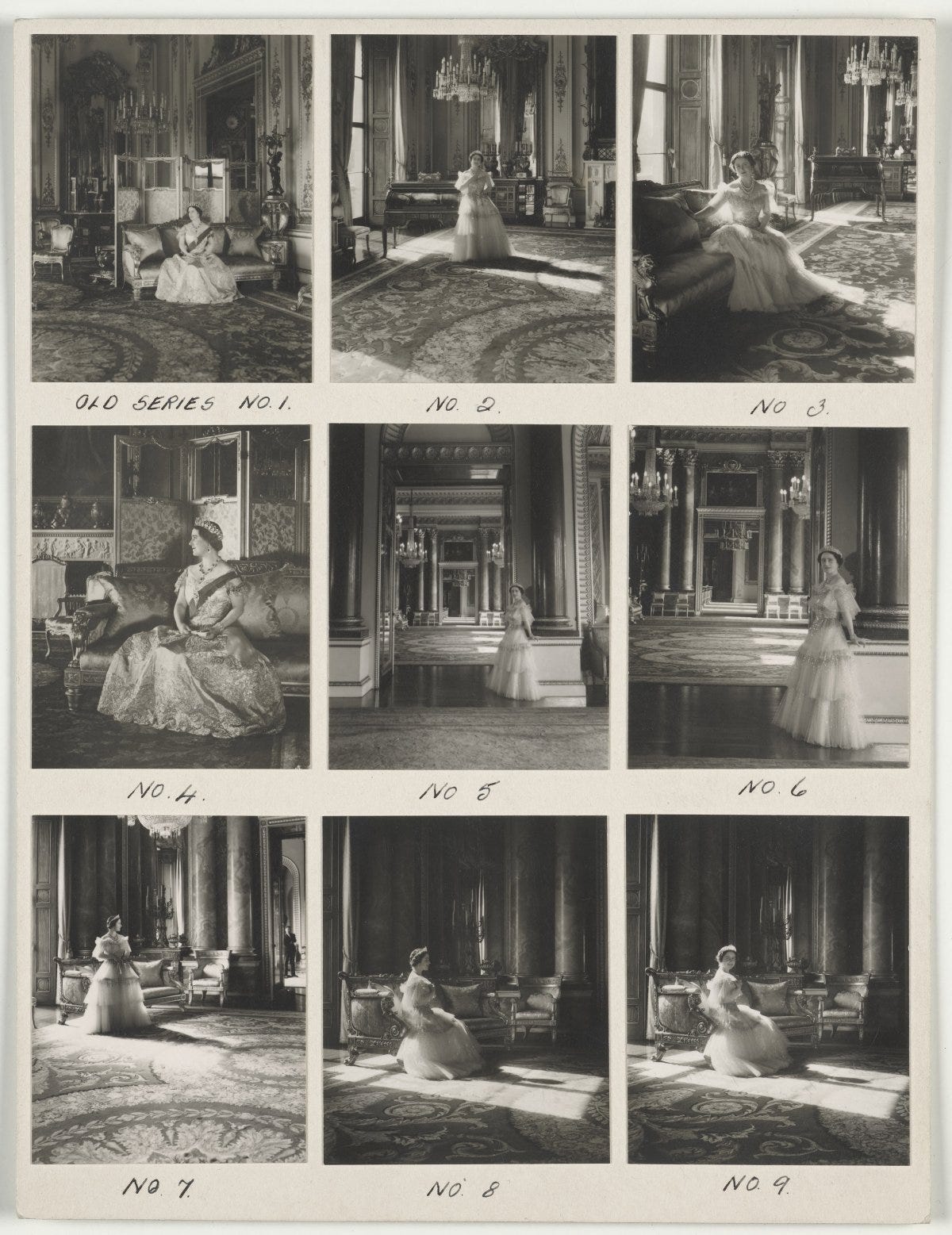
The press notes for the exhibition explain that many of the photographs on display are vintage prints, some of which have never before been displayed to the public. Also included are various archival materials related to the portraits, including unreleased proofs, correspondence from the royal family, and handwritten annotations made by the photographers. One of these proof sheets is above, showing portraits taken of Queen Elizabeth during the same 1939 sitting at Buckingham Palace.
The images show Elizabeth wearing numerous pieces of special royal jewelry from her own personal collection and from the family vaults, including Queen Victoria’s Indian Circlet and Crown Rubies and Queen Mary’s Fringe Tiara. You’ll note again here how Beaton is playing with light, using the sunlight streaming in through the palace windows to frame and highlight the queen in various shots.

The 1939 portrait session with Queen Elizabeth was a turning point in Beaton’s career. In the 1940s, Elizabeth asked Beaton to recreate that fairy-like aesthetic in portraits of her daughters, Princess Elizabeth and Princess Margaret. This portrait of Margaret was taken in 1949 to mark her 19th birthday. She wears a tulle dress decorated with sequins and butterflies, made by Sir Norman Hartnell, with luminous pearls–just like her mother in those Beaton pictures from a decade earlier.
An early episode of The Crown, Netflix’s royal soap, imagines Margaret’s dismay over the portraits, which she thought reflected her mother’s ideal image instead of her own. Her expression certainly is less serene here than the one on Queen Elizabeth’s face in the earlier images.
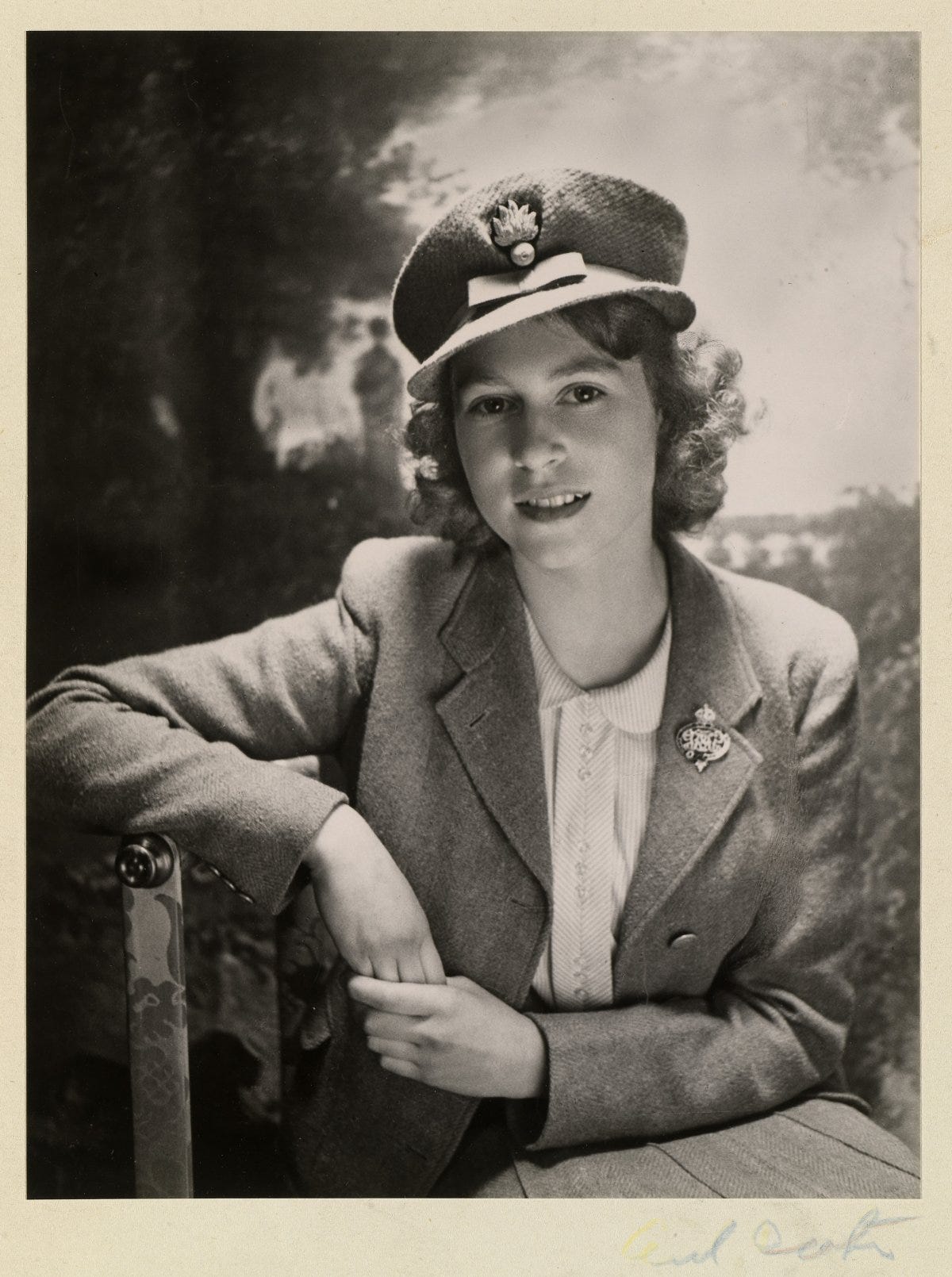
Beaton also produced ethereal portraits of Princess Elizabeth, but one of his memorable early images of the future monarch is this one, taken during World War II and featuring echoes of the military climate throughout. The young princess, just 16, had traveled from Windsor to Buckingham Palace with her parents during a visit from Eleanor Roosevelt. The family was photographed at the palace, in a session that Susanna Brown describes as “intended to show the ordinariness of the royal family” in the midst of war.
In this solo picture, Princess Elizabeth wears a tweed jacket and skirt instead of a grand Hartnell gown, and in place of fabulous royal jewels, she wears two Grenadier Guards badges. Earlier that year, she had been named Colonel-in-Chief of the regiment by her father. The picture was a great success and was reproduced on magazine covers and photo cards. That Christmas, the Grenadier Guards used the portrait as the image for their annual holiday card.

Beaton’s track record of success earned him the spectacular job of doing the official coronation portraits for Queen Elizabeth II in June 1953. Before then, though, another photographer took some iconic images of the newly-minted queen. Dorothy Wilding, a pioneering female photographer, took this portrait just weeks after Elizabeth’s accession to the throne. In the picture, Elizabeth wears one of her sparkling wedding gifts, a Cartier diamond necklace given to her by the Nizam of Hyderabad.
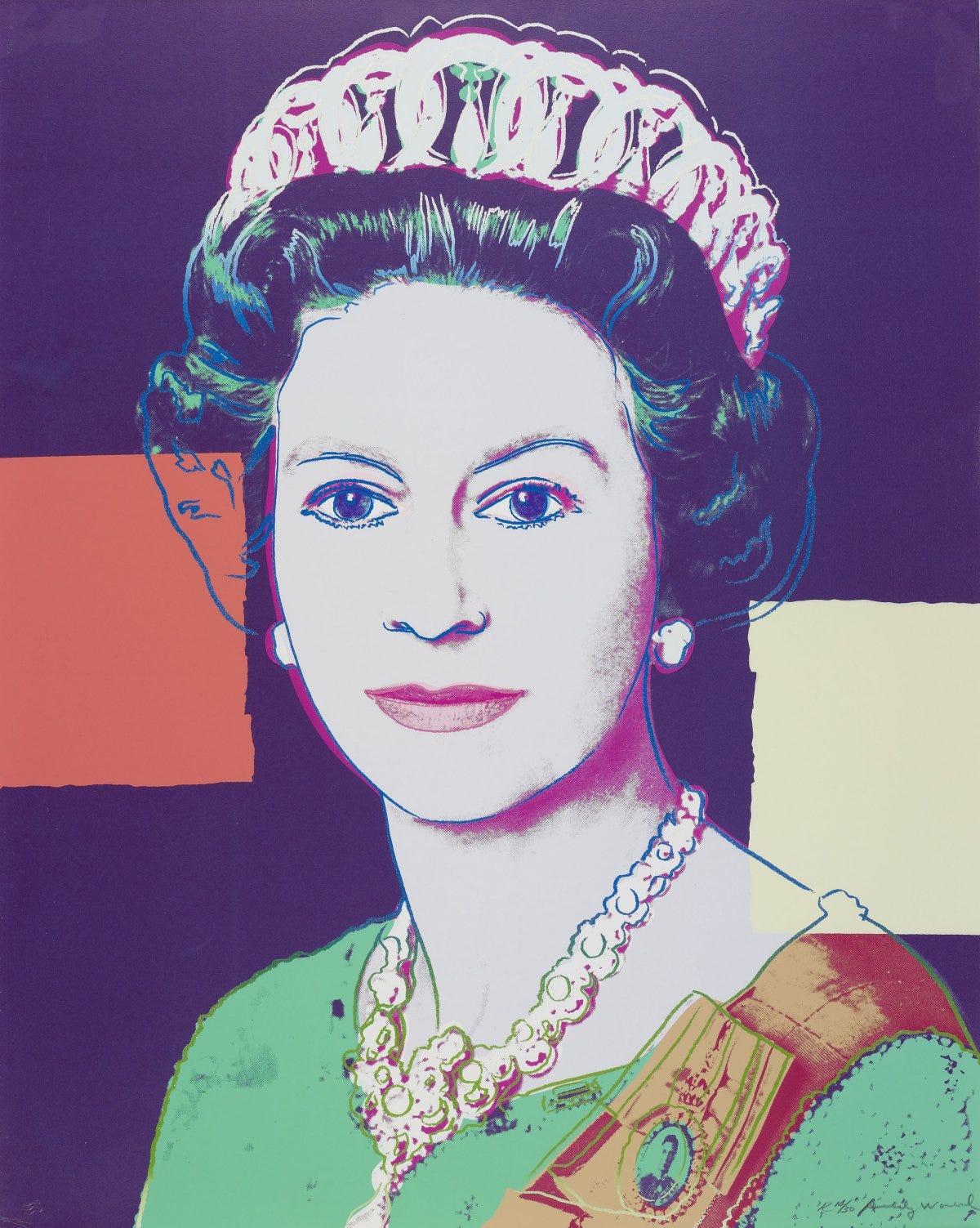
The exhibition also includes another iconic image of Queen Elizabeth II: this 1985 portrait by Andy Warhol. As a basis for his silk-screened portrait, Warhol used an official photograph taken in 1975 by Peter Grugeon and released two years later to celebrate Elizabeth’s Silver Jubilee. Elizabeth wears the pearl setting of the Vladimir Tiara and Queen Victoria’s Golden Jubilee Necklace in the original photograph. Warhol’s picture reduces the details of the original image, resulting in a stylized, symbolic portrait of monarchy. This particular version of the print is part of the so-called “Royal Edition,” a set of 30 prints that were sprinkled with “diamond dust.” The Royal Collection Trust explains, “fine particles of ground up glass … were applied to the print when wet, and sparkle in the light like diamonds.”
No exhibition of 20th century royal portraiture would be complete without images from Lord Snowdon. Antony Armstrong-Jones was a society photographer when he met Princess Margaret in the 1950s. They fell in love and married in 1960, and he produced some truly iconic images of the princess. Among them is this 1967 portrait, showing Margaret in partial profile with a bold ‘60s hairdo and one major statement earring. The antique earrings come from her personal collection. Set with diamonds and green gemstones, perhaps emeralds or tourmalines, the earrings now belong to her daughter, Lady Sarah Chatto.
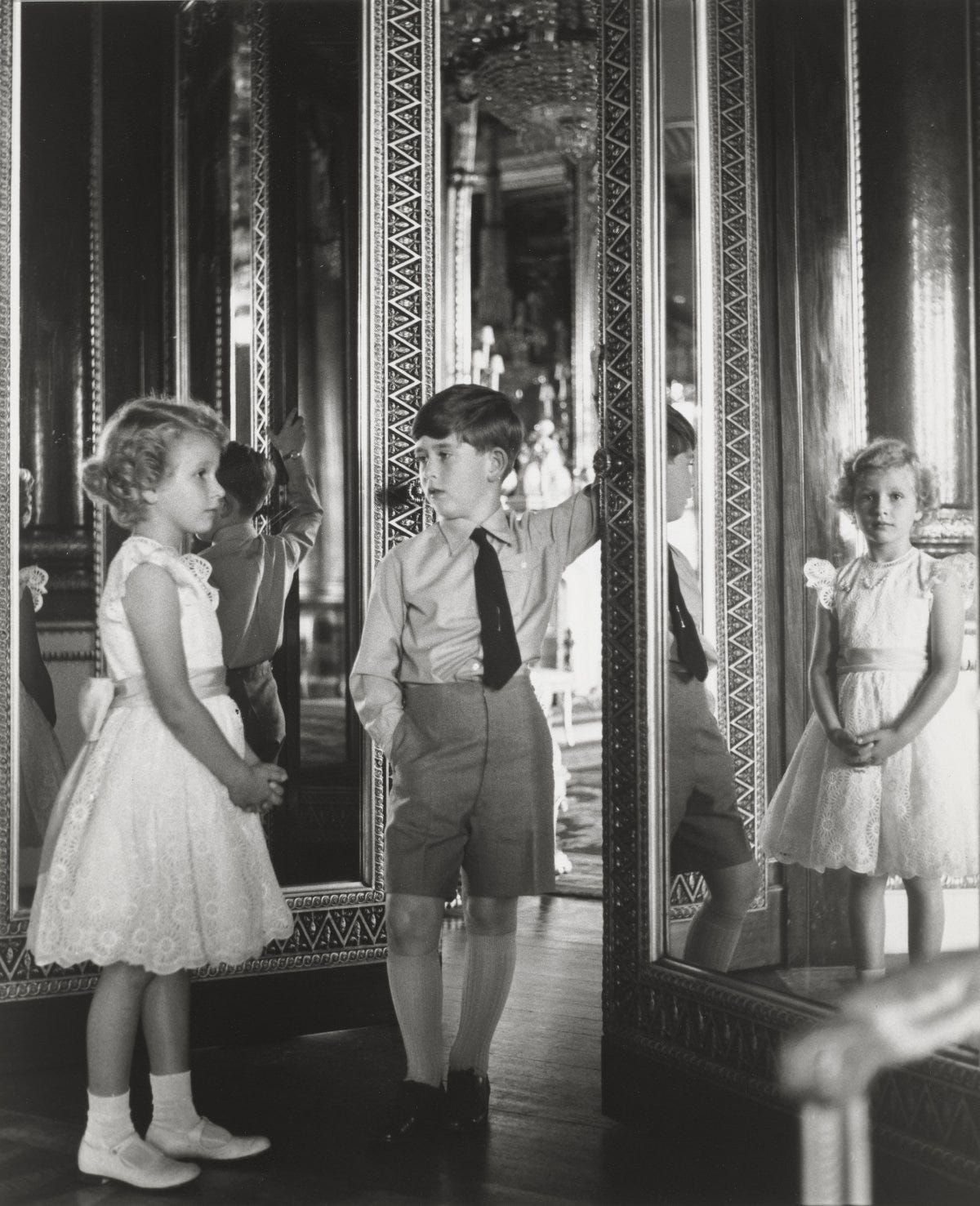
Snowdon, as he became known after receiving an earldom from Queen Elizabeth II in 1961, also took portraits of many other members of the royal family, both before and after his royal marriage. This playful portrait of Prince Charles and Princess Anne was taken at Buckingham Palace in 1956 when they were eight and six years old. Snowdon’s early reputation was bolstered by recommendations from an uncle, the theatrical producer Oliver Messel. He also worked as an assistant to Baron, the court photographer who had forged a friendship with Prince Philip.

Snowdon’s handwritten annotations are visible on this proof from a photo session with Queen Elizabeth II and Prince Philip at Buckingham Palace in October 1958. In the image, Elizabeth and Philip have returned from the State Opening of Parliament, and Elizabeth still wears her robes, gown, and jewels. With the Diamond Diadem, she wears the diamond festoon necklace commissioned by her father, King George VI. The occasion was a special one, as the event was televised that day for the very first time. You can see another Snowdon image from the same day at the National Portrait Gallery website.
The curator of this summer’s exhibition, Alessandro Nasini, shared a little bit about its importance in the press materials: “This is the first exhibition from the Royal Collection entirely dedicated to modern portrait photography, an artistic medium that has helped to shape how the world views the British monarchy. We are excited for visitors to discover the beauty and materiality of these original prints, many on display for the first time, and we hope they will also enjoy a behind-the-scenes glimpse into the creative process behind some of these iconic royal images.” Royal Portraits: A Century of Photography runs at The King’s Gallery from May 17 until October 6.
Thank you for your generous patronage of my work, both at The Court Jeweller and here at my subscriber-supported Substack, Hidden Gems. Your continued support enables me to produce quality content focusing on history, royalty, and (most importantly) jewelry.






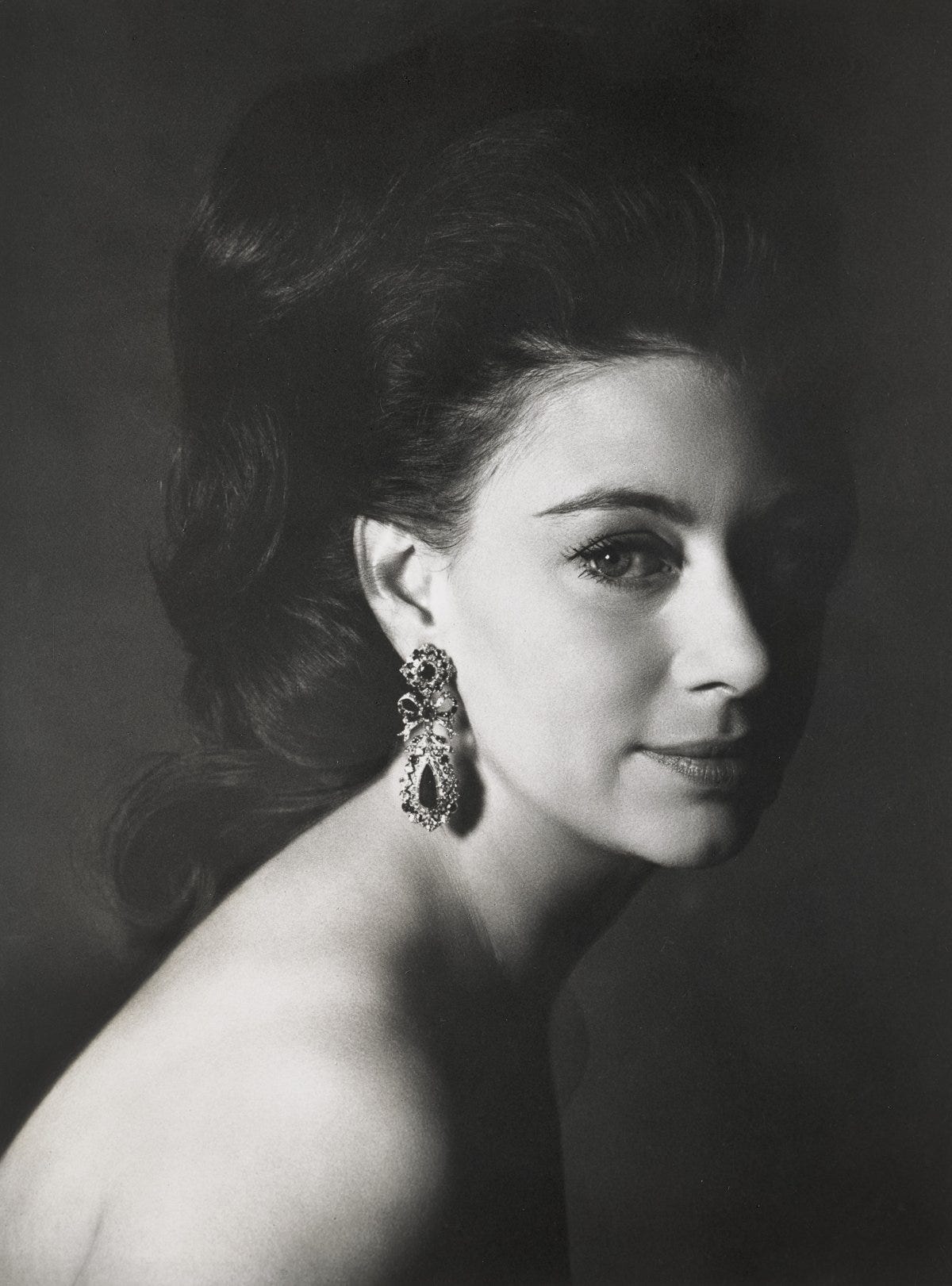
Fascinating article Lauren, thank you. It’s a pity you won’t be able to attend the press preview. Cecil Beaton’s photography was very romantic and certainly not modern, at least to me. The portraits of QEIi, her mother and sister by Parkinson’s are among my favorites. Each woman wears either pearls or diamonds or both. The Annigonni portraits of her late Majesty portray strength and feminine power. There are just so many significant royal photograhs. How lucky people who can see this exhibit will be.
I think the Grenadier Guards portrait is the one when Cecil Beaton arrived to take the portrait, he later complained that Princess Elizabeth hadn't washed her hair for the portrait session. Either way, it is a great portrait of a young woman maturing into her future role.